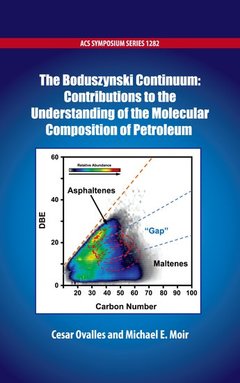Description
The Boduszynski Continuum
Contributions to the Understanding of the Molecular Composition of Petroleum
ACS Symposium Series
Coordinators: Ovalles Cesar, Moir Michael E.
Language: English
Subject for The Boduszynski Continuum:
Publication date: 05-2019
262 p. · 15.8x23.6 cm · Hardback
262 p. · 15.8x23.6 cm · Hardback
Description
/li>Biography
/li>
This monograph covers three broad topics of Mietek's outstanding career, Heavy Fraction and Asphaltene Characterization, The Boduszynski Continuum Model, and Distillation. In his pioneering work, Dr. Boduszynski postulated that petroleum is a continuum of compounds having a wide variety of structural and elemental compositions. The model proposed that, unlike conventional wisdom at the time, petroleum transitions from individual molecules to high molecular weight components (i.e., asphaltenes), and that the molecular composition of petroleum is a continuously variable series of molecules without abrupt transitions. His work in this area forms the basis of the current model of petroleum. He predicted that the high-boiling residue after distillation was, in fact, a continuous extension of low molecular weight components, rather than (as was then thought) high-molecular weight "polymers."
Cesar Ovalles is Technical Team Leader at Chevron Energy Technology Company. He has a B.Sc. in Chemistry from Simon Bolivar University and Ph.D. in the same field from Texas A&M University. He worked for 16 years at Petróleos de Venezuela Sociedad Anónima-Instituto de Tecnología Venezolano del Petróleo. In 2006, he joined Chevron to work in R&D in Petroleum Chemistry and characterization of heavy and extra-heavy Crude Oils and their fractions. He is also involved in new methods for analysis of asphaltenes and R&D in the chemistry of heavy and extra-heavy crude oil upgrading processes. He currently supervises a 7-member team in a variety of projects. Michael Moir is the manager of the Petroleum and Materials Characterization Unit of the Chevron Energy Technology Company. Michael obtained his B.Sc. in chemistry from Queen's University at Kingston, Ontario, Canada and his Ph.D. in physical organic chemistry from the University of Alberta. He worked for 11 years in the research department of Imperial Oil Resources Limited in Calgary, Alberta before joining Chevron in 1996. He has made contributions in a diverse range of research pursuits, from organic geochronology to remediation of crude oil impacted sites, and now leads a group of about 60 scientists and technicians dedicated to the understanding of the physical and chemical nature of crude oil and its products. Michael has contributed to more than 50 publications, and he has been awarded 16 U.S. Patents.
© 2024 LAVOISIER S.A.S.



